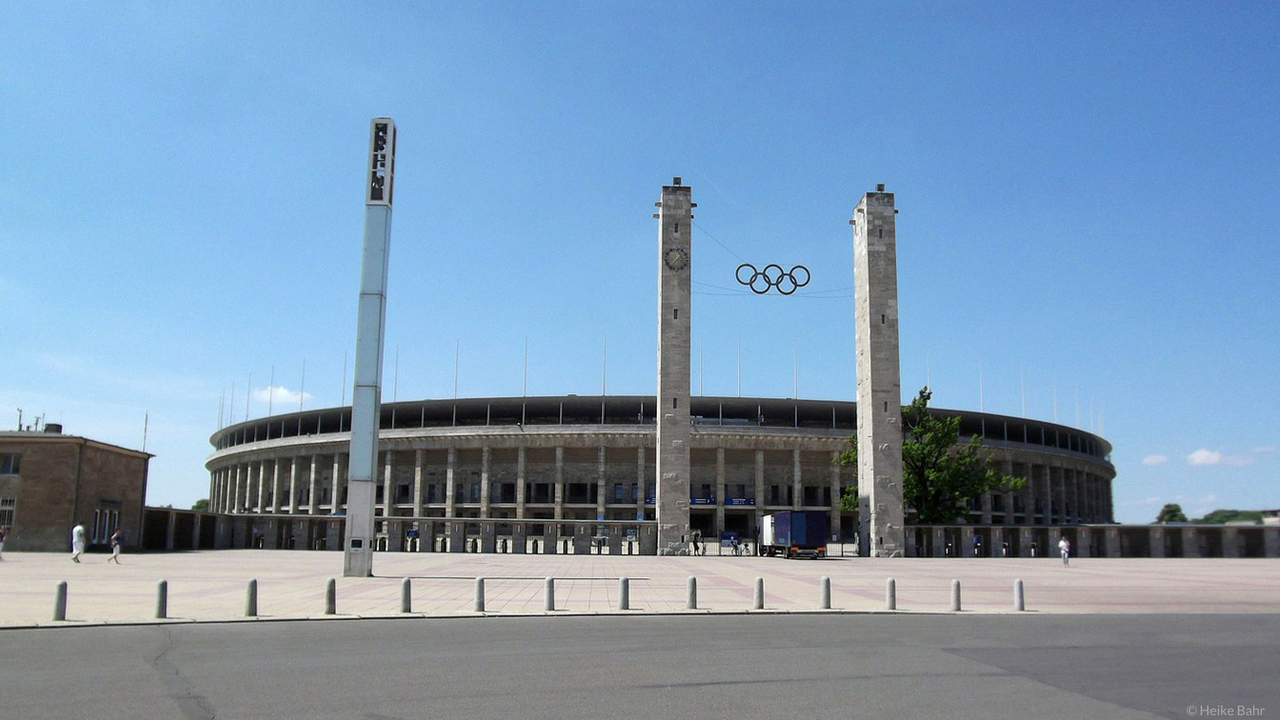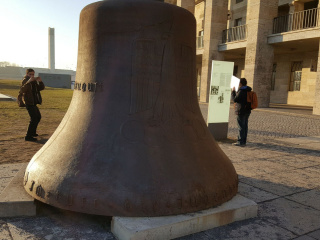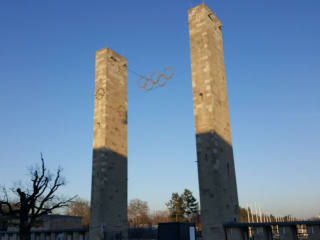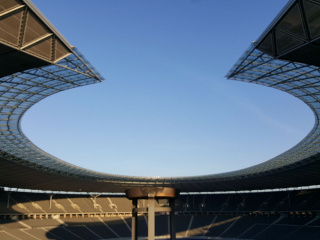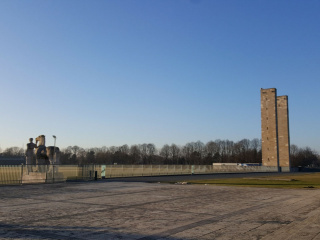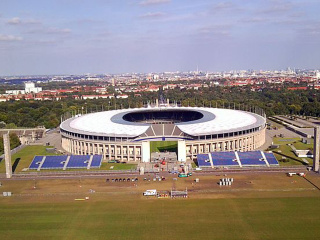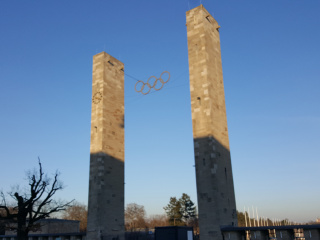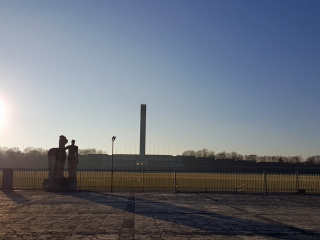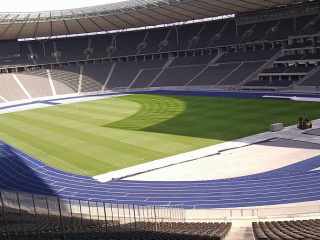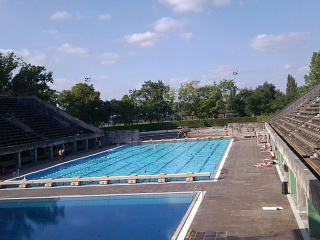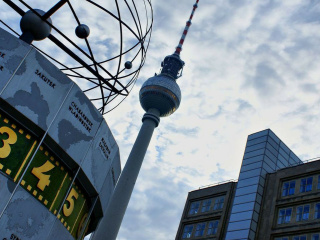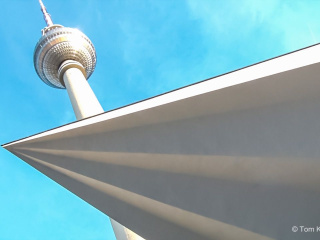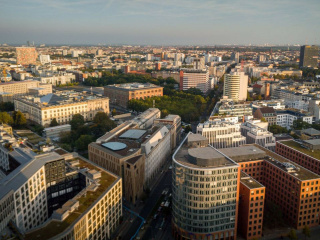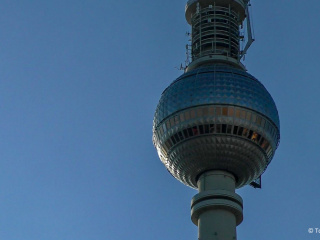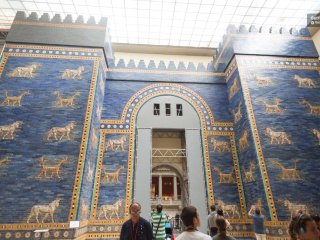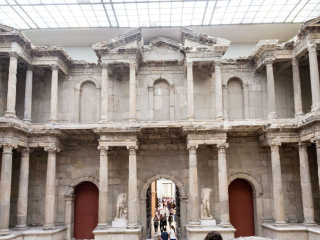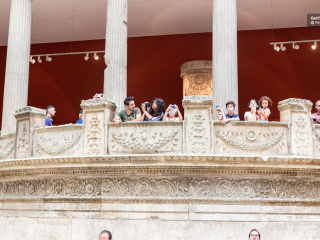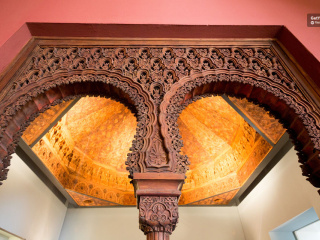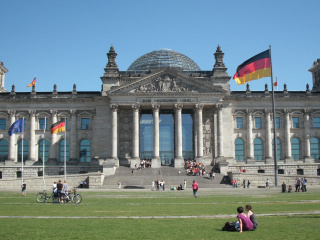The Olympiastadion is the home of Hertha BSC. If you enter the stadium, you can see the blue tartan track. The Olympiastadium can look back on a far-reaching history.
German Stadion from 1909 to 1916
On May 23, 1909, the Grunewald racetrack, designed by Otto March, was opened. 40,000 spectators participated and in the middle was an 85,000m² pit in which the stage was supposed to be built. For many years, the German Reich tried to bring the Olympic Summer Games to Berlin. In 1912 Berlin was finally chosen to host the 1916 Games. The total costs were estimated at 2.25 million reichsmarks. In August 1912 the works for the German Stadium started, comprising 11,500 seats, 18,500 standing places and a further 3,000 spectators took place at the swimming pool. After only 200 days of construction, it was completed on May 15, 2013. Unfortunately, the time it was used was very short. Europe fell into the First World War, and the stadium was closed on July 26, 1914, starting from 1915 it served as a military hospital. It was not used again until 1916 for sporting purposes.
German Sportforum from 1917 to 1929
The German University for body exercises was founded May 15, 1920, in the Berlin Friedrich-Wilhelm-University (today Humboldt University). The main building north of the stadium’s swimming pool was built. The new facility was inaugurated with a gym, a fencing floor, a dining and reading room on 26 May 1922, and opened its doors. Theodor Lewand suggested the name "Sportforum" for the new building complex, but the name did not find much support in Berlin. However, the name "Sportforum" spread very quickly. On September 16, 1925, the entire area was called "Deutsches Sportforum", and so it is still named today. The foundation was laid on October 18, 1925, although there were still no drafts for the Forum. The competition was won by the brothers Werner and Walter March, the architects of the German Stadium. Again, the dream of hosting the Olympic summer games in Berlin appeared, so new plans were made to increase the capacity of the stadium to 65,000 spectators. This dream was again unfortunately destroyed, due to the global economic crisis.
Plans for reconstructions from 1930 to 1933
At last, the dream was about to come true. At the 9th Olympic Congress of the IOC Berlin’s invitation for the Games in 1936 was announced. May 13, 1931, the votes were counted, and Berlin won against Barcelona. The drafts of Werner March were held on to.
On January 30, 1933, Adolf Hitler was appointed chancellor of Germany, and the discussion about the stadium construction began. The project received a new name "Reichsportfeld," and after many, the third draft of the brothers March was accepted on 14th December 1933, but this involved the demolition of the stadium. The new plan included: the stadium should be deepened by ten meters. Included in the plan (which were realized later): Olympic square, Olympic Stadium, a marshalling grounds with a "guide tower", a bell tower, Coubertin square and swimming hall.
The construction of the Olympic Stadion, 1934 to 1936
The demolition of the tribunes and the horse race track started in March 1934.
Adolf Hitler had appointed the Ministry for internal affairs as the head of the constructions. At the beginning of the development, both brothers, Werner and Walter March were selected as architects, later only Werner March. The construction was falling behind the schedule right from the beginning. State Secretary Pfundtner put pressure on the construction companies. He threatened to replace them, and obliged the construction companies to employ only "deserving workers of German nationality and Aryan descent". In 1935, 1,500 workers were employed for the building. In July 1935 it rose to 2,064. The construction went according to schedule now. Probably 500 companies were hired. No one knew what the exact costs were. There are no indications, but some estimate it at at least 27 million marks.
Olympic Summer Games 1936
Now it was time. The XI. Olympic summer games were opened August 1, 1936. 3,956 athletes from 49 nations participated in the competitions. The Reichshauptstadt showed itself at its best, and Adolf Hitler informed that the NSDAP "will not trouble the Olympic Games" and will not be opposed to the participation of coloured people in these competitions ".
Germany was leading the unofficial national rating, with 33 gold, 26 silver and 30 bronze medals in front of the USA. On August 16, 1936, the games were concluded with a grand closing ceremony. After the Olympic Games, the Reichsportfeld was still used for large events.
With the order of Adolf Hitler on April 15, 1936, the Reichsakademie for body exercises was established. It replaced the university for body exercises, in other words, the university had to be shut down. Study assistants were to receive a "unitary training in the field of physical education", but it was para military SA sport.
2nd World War from 1937 to 1945
On June 20, 1937, the first finale for the German Football Championship took place. The winner was FC Schalke 04. During first years of WW2 "war championships" took place here. The Reichsportfeld was prepared for the war very early. Inside the Marathon tunnel, catacombs were drafted, the catacombs were there to be converted into a bunker. The company Blaupunkt produced igniter for air defence firearms at the beginning of the war. The stadium then became a depot for the Großdeutschen Rundfunk, food and wine were stored inside the buildings, and the Olympic Place was one of ten places where Hitler's last squads were fighting, November 12, 1944.
Postwar - 1945
The cleanup began in May 1945 after the unconditional surrender. A field devastated by bullets, empty ammunition crates, downcast concrete parts and corpses. Almost everything was in ruins or was partly destroyed. In the Maifledtribüne, film reels ignited, the fire broke into the bell tower, which burnt out completely. The Red Army occupied the House of Sports and built barracks there. Carl Diem, who was the Secretary General of the Organizing Committee for the Olympic Games of 1936, was appointed Director of the Reichsportfeldverwaltung.
The swimming stadium, however, was almost untouched by the bombs, so Diem opened it on the 20th June 1945 for the population, which of course was immediately accepted. Unfortunately, it was only for a short time. With the occupation of the Reichsportfeldes by the British on 1 July 1945, it was stopped. From now on the British claimed the facilities.
Occupation - 1946 to 1956
On September 7 and 8, 1946, the British opened the stadium for the "Eight Nations Sports Festival", the athletic championships of the Allied soldiers. The Olympiagelände lost its landmark on 15 February 1947. The burned-out bell tower was blown up because of dilapidation. At the fall, the coat of the bell got a long crack. British pioneers buried it in May 1947, so that metal thieves could not steal it. On 12 June 1947, Max Schmeling played his last boxing match on the open-air stage, which was called "Waldbühne". The stadium was handed back to the German authorities on June 12, 1949, and a year later the Senate decided to rename the "Reichsportfeld" to "Olympiastadium". The bell was excavated again on 18 December 1956. Werner March, who also had considerable influence on the elevation of the bell, supported the reconstruction of the bell tower, which was completed in 1962. The height of the tower is 77.17 meters.
Conservation and Canopy- 1957 to 1988
In 1957, the "Führer Lodge" was shortened by one meter. Thus the historical brisance was taken. The former Reichssportfeld was added 1966 into the Denkmalliste (conversation list) of Berlin West. A newly installed floodlight system was inaugurated in November 1966. In 1969, the cinder track was replaced by a plastic runway.The stadium was given a partial roof on the occasion of the 1974 World Cup, which protected 26,000 spectators from the weather. The press platform was renovated, the changing rooms and toilets for the spectators were modernized.
Application for Olympics 2014 - 1989 to 1997
Once again, Berlin wanted to apply for the Olympics, but unfortunately, the dream had already disappeared in the first round September 23, 1993. After nearly 50 years, the military presence of Great Britain ended on the 8th September 1994. British Prime Minister John Major and the Governing Mayor of Berlin, Eberhard Diepgen, unveiled a commemorative plaque at the Eagle Square in front of the House of German sport.
Preparation for restoration - 2000 to 2004
On July 3, 2000, the first turn of the shovel was celebrated. The reconstruction and renovation of the ailing building could begin. The lower ring had to be completely renewed, whereby the upper ring was largely in tact. The restoration happened during the games. The Walter Bau-Ag guaranteed that all home games could be played during the construction phase, with 55,000 seats and at the Cup finals even 70,000 seats. The only event that had to move during the construction was the ISTAF. It transferred to the Ludwig-Jahn-Sportpark.
New opening - 2004
The stadium was handed over to a new management in the summer of 2004 and was inaugurated on 31st July with a big celebration. On an event-free day, tourists and Berliners can visit the Olympic stadium. The last work continued until 2006. Everything was ready for the FIFA World Cup. The final on 9 July took place at the Olympiastadion Berlin.
"Five Star Stadion" - 2005
The Olympic stadium was rated as a "five-star stadium" by the stadium commission of the European Football Union (UEFA) in April 2005. It is the highest possible rating of the stadiums in Europe.
The Summer’s tale- 2006
The sports highlight in 2006 was the FIFA World Cup. Six games were played at the Olympics. The memorable quarter-final match Germany - Argentina, which decided the future World bronze medalist Germany on penalties. The final on July 9 was between Italy and France. The Squadra Azzurra won in the final only in the penalty shoot-out and thus became the 18th Football World Champion at the Olympiastadion. The chapel inside the Olympiastadion was inaugurated on time. It is not only available to the athletes but also for weddings or baptisms.
Athletics World Championship Berlin - 2009
The 12th IAAF World Athletics Championships took place in the Olympiastadion in 2009. Approximately 400,000 visitors celebrated world records and countless national records in nine days.
To this day, many concerts are held in the Olympiastadion.
Many famous bands, such as U2, who holds the record for an audience of over 90,000 fans.
Tickets and concerts can be found at Event
Tickets can be found here
Address: Olympischer Platz 3, 14053 Berlin
Opening times: January to March: 10am. - 4pm.,April to October: 9am. - 7pm., August: 9am. - 8pm.
Admission: 7 Euro, reduced: 5,50 Euro
Public transport: U Station Olympiastadion (U2)
more Berlin Tips:




